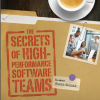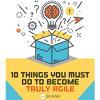 |
The Veracity about Velocity Novice project management, measurement analysts, and even leadership may attempt to use velocity (an indicator of workload completed) comparisons to drive innovation and improvement across teams. In turn, teams are then motivated to inflate story points and velocity while losing perspective of their true purpose: value delivery.
|
|
 |
Is Iterative Development Still Relevant? Iterative development is a forerunner of Agile and can be seen as a hybrid retaining some aspects of Waterfall. This article looks at whether it is still of value to project delivery and in what circumstances it could be useful.
|
|
 |
Finding the Sweet Spot Between Order and Chaos Agile gives us complete freedom and ownership over the development process, but without a healthy measure of self-organization and management, all of that autonomy will not amount to much. Let’s take a look at the chaos and order aspect of agile and how you can embrace both.
|
|
 |
The Agile Methodologies and Mindset That Got Us Through the COVID-19 Pandemic The landscape of modern technology as well as the way it impacts business operations has transformed since agile methodologies were created. In the past 18 months, that rate of change has greatly accelerated. Let's take a look at just how much agile has helped us adapt to this uncertain time as well as the way that COVID-19 has impacted the agile principles that we can continue to rely on.
|
|
 |
The Secrets of High-Performance Software Teams Of all issues that impact getting quality products out on time, the team should never focus on simply managing costs. To minimize the risk of perpetual product delivery delays, define what “done” really means.
|
|
 |
You Get What You Tolerate We’ve all worked with a talented developer who can be a frustrating challenge to manage. First-time managers may unknowingly encourage bad behavior. There are several innovative ways to resolve the situation.
|
|
 |
Achieving Continuous Improvement and Innovation in Software There is tremendous pressure on software development teams to deliver software faster, better, and cheaper. Quality engineering with a focus on innovation is the answer
|
|
 |
10 Things You Must Do to Become Truly Agile Agile is not a state of doing; it’s a state of being. Adopting business models on value and learning how to make teams autonomous are both necessary steps to reap the benefit of agility.
|
|
 |
Tear It Down to Build It Up: Using Agile in Construction Project Management
Slideshow
Operating on the philosophy that one must thoroughly know the rules before one can break them, a global company developed its own delivery model that is still as true to the agile mindset as is possible. Join Arjay Hinek in this lively session as he deconstructs his company's experiment in melding agile with construction project management to create a hybrid delivery model. At first, the teams were struggling with clear ownership, timely communication, and clear follow-through on work in progress. From modifying the user story mapping model in order to improve project initiation to dissecting and rewriting the values and principles of the Agile Manifesto, Arjay stretched agile practices to the limit to help his teams strive and grow through iterative and incremental delivery. Arjay will share the struggles, failures, and successes of this innovative experiment.
|
Arjay Hinek
|
 |
Test Management in Agile—What Happened to All My Testers?
Slideshow
Substantial confusion exists about the roles and responsibilities of test management when using an agile software development process. Agile seeks to streamline project management and leadership under the role of a ScrumMaster, but what does this mean for test managers? How do they stay...
|
Jeffery Payne
|
 |
Testing at 43,000 Feet: Reporting Risk That Matters
Slideshow
Testing dashboards can give stakeholders the false impression that projects are under control. But are they really? As a tester, you can see a counter indicating a high percentage of passing tests but know that you may still have critical failures in the product. Alexandre Bauduin will...
|
Alexandre Bauduin
|
 |
Behavior-Driven Development: Real-World Mind Reading
Slideshow
Imagine this scenario: Business users are excited to finally get their hands on an implementation delivery that is on schedule, (mostly) on budget, and passed rigorous testing with flying colors. Unfortunately, when working with the new app or feature, the users realize that the way they described their needs didn’t translate into what they actually needed. Sound familiar? While she may not be able to offer telekinetic mind-reading tools, Kim Tatum is convinced that leveraging a behavior-driven development (BDD) approach helps bridge the gap between domain experts and technical teams. Join Kim to discuss how natural, human-readable language ultimately creates shared accountability and reduces misunderstandings. Review how this framework is implemented on a variety of delivery projects and walk through an implementation approach and leading practices.
|
Kim Tatum
|
Visit Our Other Communities
CMCrossroads is a TechWell community.
Through conferences, training, consulting, and online resources, TechWell helps you develop and deliver great software every day.
